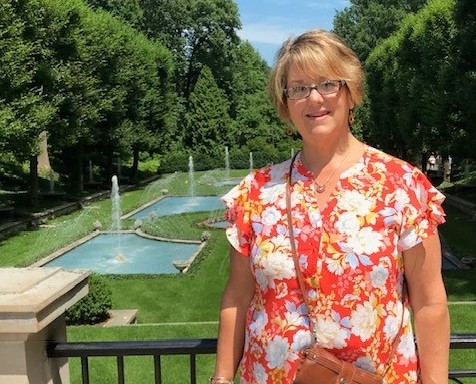Community member brings important perspective to Community-Engaged Research Core

Bonnie Kent is all about northern Dauphin County. For more than 30 years, she has been active in her hometown communities, currently serving as a community mobilizer with Dauphin County. In this position, she looks for ways to fill gaps of services and engage community and organizations to work collectively together for positive change. Her commitment and connections to northern Dauphin County made her a perfect addition to the Community-Engaged Research Core of Penn State Clinical and Translational Science Institute when it was looking for its first community team member.
“Having a community member on our team is important to ensure our work resonates with those we are working to serve,” Dr. Jennifer Kraschnewski, co-director of the core, said. “Community members bring new perspectives to the table that may not have been considered by our academic team. Bonnie truly has her finger on the pulse of her community and having her insight and reflections on the core’s aims has helped us ensure the direction of our work makes sense beyond the walls of Penn State.”
The Community-Engaged Research Core is one of nine that the institute uses to assist Penn State researchers conduct their research more efficiently. Some of its services include assistance with the engagement of communities and research teams to form strategic partnerships, the inclusion of communities as partners in research, and the development of community health coalitions. From a research vantage point, the core aims to develop practices for successful university and community partnerships which can be shared throughout the National Institutes of Health’s Clinical and Translational Science Award Network.
Adding a community member to the team adds an important voice to the core’s mission.
“For example, when discussing our new pilot project looking at the unique social and economic problems in rural communities leading to health problems, Bonnie’s critical understanding of the community’s struggles helped to inform key variables as we developed the project,” Kraschnewski said. “Ensuring this data-driven model reflects important community indicators will allow for more accurate determination of social and economic factors that contribute to poor health, and ultimately, a greater ability to identify potential solutions.”
Kent brings many different perspectives to the team. Her family owned several businesses in the community and she’s still active in helping manage one of them. It gave her a perspective on helping others.
“My parents were true entrepreneurs at heart: they worked seven days a week, 16-hour days and enjoyed serving others,” Kent said. “I’m one of four children and we were all expected to work the family businesses. It helped us to be a close supportive family and acquire strong work ethic as well as to become customer service driven. Personally, I have been through some tough situations in life and find I can let those experiences anchor me down or use them to grow. I chose the latter. I believe empathy for another human being is often underutilized and I often think when someone presents a need, ‘what if this were someone I loved? How much effort would I put into this situation then?’ It helps me to focus on doing the best I can for each individual. ”
Since 2009, she has been the operation manager and community liaison for the Northern Dauphin Human Services Center located in Elizabethville. The center is home to 14 service agencies and also to numerous organizations that utilize the facility. The center services residents of Halifax, Millersburg, Upper Dauphin and Williams Valley School Districts.
“Many new services and programs have been implemented throughout the 10 years the center has been here, “Kent said. “We have grown into a community center. People come here for help and to help others. I love a happy ending to a story and that drives me to cheerlead others to be the best they can be in their journey in life. It is amazing when someone calls or stops by because they have news to share that has changed their lives for the better. I love building those relationships. Sometimes that relationship started with a broken spirit and slowly, as you grow and build trust, you start to see some light come back into their life and hope begin to take shape. We make people feel like family here.”
Projects have included creation of a community garden and an employment center, becoming a Salvation Army Unit and a Prosperity Center, implementing adult literacy classes, an annual project to provide prom gowns, and back to school program that provides school supplies, clothes and a haircut for students preparing for the first day of school.
“We are currently working with local businesses and organizations to implement a new transportation program which will offer rides to doctor appointments, employment and grocery stores,” Kent said. “There are other conversations for the need for shelters, recovery houses and career centers, all of which are at least a 30-mile drive away to obtain. I want to continue to encourage our community to continue to grow and strengthen our neighborhoods.”
The Community-Engaged Research Core is working to add similar community representation throughout the Clinical and Translational Science Institute.
“Engaging diverse perspectives from outside academia will help with the Clinical and Translational Science Institute’s relevancy to the community in which we live,” Kraschnewski said. “Ultimately, this will allow for more successful translation of our research efforts to help our neighbors.”
The addition of Kent to the Community-Engaged Research Core has also helped Kent better understand the effect Penn State has on its communities and the role of research throughout the university.
“The strengths of Penn State is like a gift yet to be unwrapped by the community,” Kent said. “Once others are engaged and offered the opportunity for growth, they too will be surprised by the promise of a brighter tomorrow from the knowledge of yesterday.”
If you're having trouble accessing this content, or would like it in another format, please email Penn State Health Marketing & Communications.
